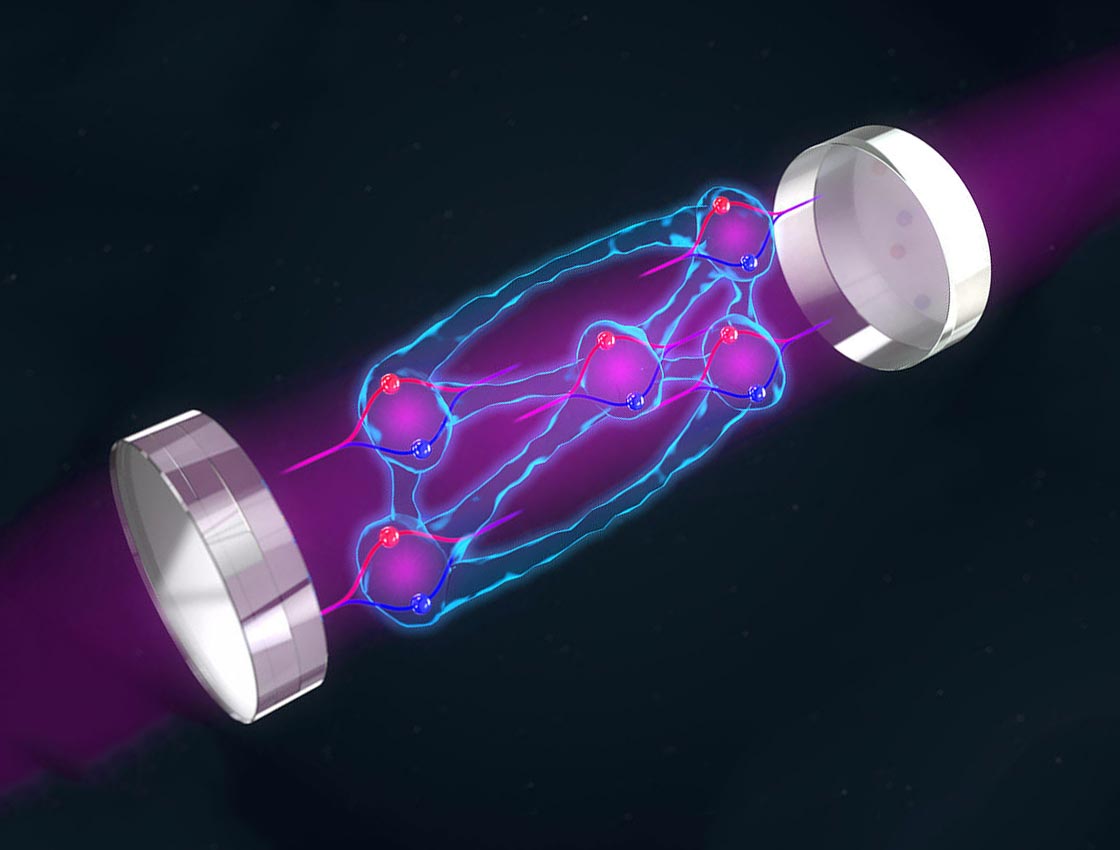
En gjengivelse av de sammenfiltrede atomene i interferometeret. Kreditt: Steven Burrows, Thompson Group/JILA
Et team av forskere ved JILA har for første gang vellykket kombinert to av de “skummelste” egenskapene til kvantemekanikk for å lage en bedre kvantesensor: sammenfiltring mellom atomer og delokalisering av atomer. JILA er et fysisk vitenskapelig forskningsinstitutt som drives av National Institute of Standards and Technology (NIST) og University of Colorado Boulder.
For første gang har forskere med suksess kombinert to av de “skummelste” egenskapene til kvantemekanikk for å lage en bedre kvantesensor: sammenfiltring mellom atomer og delokalisering av atomer. Prestasjonen ble oppnådd av JILA og NIST-stipendiat James K. Thompsons team av forskere.
Einstein refererte opprinnelig til sammenfiltring som å skape skummel handling på avstand – den merkelige effekten av kvantemekanikk hvor det som skjer med en[{” attribute=””>atom somehow influences another atom located somewhere else. Entanglement is at the heart of the envisioned quantum computers, quantum simulators, and quantum sensors of the future. A second rather spooky aspect of quantum mechanics is delocalization, the fact that a single atom can be in more than one place at the same time.
“By learning to harness and control all of the spookiness we already know about, maybe we can discover new spooky things about the universe that we haven’t even thought of yet!” — James K. Thompson
As described in their paper that was published in the journal Nature on October 19, the Thompson group has combined the spookiness of both entanglement and delocalization to realize a matter-wave interferometer that can sense accelerations with a precision that surpasses the standard quantum limit (a limit on the
Using this technique, the group designed two distinct experimental approaches, both of which they utilized in their recent work. In the first approach, called a quantum nondemolition measurement, they make a premeasurement of the quantum noise associated with their atoms and simply subtract the quantum noise from their final measurement. In a second approach, light injected into the cavity causes the atoms to undergo one-axis twisting, a process in which the quantum noise of each atom becomes correlated with the quantum noise of all the other atoms so that they can conspire together to become quieter.
“The atoms are kind of like kids shushing each other to be quiet so they can hear about the party the teacher has promised them, but here it’s the entanglement that does the shushing,” says Thompson.
Matter-wave Interferometer
One of the most precise and accurate quantum sensors today is the matter-wave interferometer. The idea is that one uses pulses of light to cause atoms to simultaneously move and not move by having both absorbed and not absorbed laser light. This causes the atoms over time to simultaneously be in two different places at once.
As graduate student Chengyi Luo explained, “We shine laser beams on the atoms so we actually split each atom’s quantum wave packet in two, in other words, the particle actually exists in two separate spaces at the same time.”
Later pulses of laser light then reverse the process bringing the quantum wave packets back together so that any changes in the environment such as accelerations or rotations can be sensed by a measurable amount of interference happening to the two parts of the atomic wave packet, much like is done with light fields in normal interferometers, but here with de’Broglie waves, or waves made of matter.
The team of JILA graduate students figured out how to make all of this work inside an optical cavity with highly-reflective mirrors. They could measure how far the atoms fell along the vertically-oriented cavity due to gravity in a quantum version of Galileo’s gravity experiment dropping items from the Leaning Tower of Pisa, but with all the benefits of precision and accuracy that comes along from quantum mechanics.
Doubling the Spookiness
By learning how to operate a matter-wave interferometer inside of an optical cavity, the team of graduate students led by Chengyi Luo and Graham Greve was then able to take advantage of the light-matter interactions to create entanglement between the different atoms to make a quieter and more precise measurement of the acceleration due to gravity. This is the first time that anyone has been able to observe a matter-wave interferometer with a precision that surpasses the standard quantum limit on precision set by the quantum noise of unentangled atoms.
Thanks to the enhanced precision, researchers like Luo and Thompson see many future benefits for utilizing entanglement as a resource in quantum sensors. Thompson says, “I think that one day we will be able to introduce entanglement into matter-wave interferometers for detecting gravitational waves in space, or for dark matter searches—things that probe fundamental physics, as well as devices that can be used for everyday applications such as navigation or geodesy.”
With this momentous experimental advance, Thompson and his team hope that others will use this new entangled interferometer approach to lead to other advances in the field of physics. With optimism, Thompson says, “By learning to harness and control all of the spookiness we already know about, maybe we can discover new spooky things about the universe that we haven’t even thought of yet!”
Reference: “Entanglement-enhanced matter-wave interferometry in a high-finesse cavity” by Graham P. Greve, Chengyi Luo, Baochen Wu and James K. Thompson, 19 October 2022, Nature.
DOI: 10.1038/s41586-022-05197-9